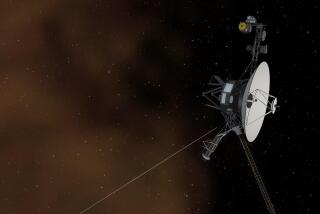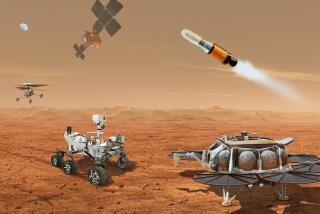Kepler telescope getting a makeover? Join the NASA spacecraft club
NASA’s planet-hunting Kepler spacecraft may be down a couple wheels, but it’s by no means out for the count, mission scientists said Thursday. As part of a time-honored tradition, the space agency is calling on scientists and engineers to submit ideas for new ways to prop up the telescope and pull more scientific discoveries out of its still-working instrument.
Every mission NASA sends out into space has a limited lifetime – even the Voyager spacecraft, launched in the 1970s and still making news today. Some spacecraft end up malfunctioning. Others eventually run out of fuel – or, in the case of the Spitzer space telescope, the coolant that keeps its infrared instruments in working order.
Still, NASA has a long history of repurposing old or malfunctioning spacecraft, said Eric Ford, an astronomer at Pennsylvania State University.
“It’s very common,” Ford said. “Oftentimes you design a spacecraft with everything you want to do but inevitably, at some point, something won’t work. And then you have to figure out, what do we do?”
NASA has most recently taken two spy telescopes donated by the U.S. National Reconnaissance Office to potentially rework them for scientific missions.
Then there are spacecraft like the 2004 Mars rover Opportunity, which has outlived its 90-day warranty nearly 40 times over. Ailing as it is, the researchers have found new ways to use some of its instruments and even explore new territory on the Red Planet.
Perhaps the most famous example of making do is the scene immortalized in the 1995 film “Apollo 13,” when ground-based engineers figured out how to make a carbon dioxide filter that would keep the astronauts from suffocating – using only parts available to the astronauts aboard the spacecraft.
Less dramatically, when Spitzer’s coolant ran out, scientists were able to continue using tools in the telescope’s infrared array camera to keep looking for objects like asteroids, dusty stars and distant galaxies.
And yet, in spite of these many examples of rebirth and reinvention, the first signs that Kepler may have been hobbled for good were met with profound dismay.
“Tears are coming to my eyes on and off,” Geoff Marcy, a UC Berkeley astrophysicist and mission co-investigator, said at the time. (He wrote something of a farewell ode, as well.)
The distress could possibly be attributed to the idea that Kepler is, in some ways, a one-trick pony, Ford said. Spitzer had several instruments. So do the rovers. But Kepler has just one instrument, which it uses to stare at a single patch of sky.
Nonetheless, there are plenty of things that can still be done with the spacecraft, scientists said.
Kepler project scientist Steve Howell, an astrophysicist at NASA’s Ames Research Center in Mountain View who is leading the effort to decide how Kepler might be repurposed, said the Kepler team had its own ideas about how the craft might still prove useful, but that the group was asking for the white papers to “make sure we’re not in a bubble.”
Those papers are due by Sept. 3 and will be posted on the Kepler Science Center Web pages on Sept. 4, he said. But scientists had already suggested a few ideas, he added.
Some advocate pointing Kepler at the same field of view, but focusing on different types of targets, such as larger exoplanets or the stars themselves. Because the telescope can also be pointed toward the sun, others have suggested shifting its field of view and using it to study objects in the inner solar system, such as asteroids that might be heading toward Earth. Others still would like to use it to survey active galaxies.
Others aren’t waiting to make their ideas public, posting to the Arxiv website possible new ways to use the malfunctioning spacecraft – some with software updates, others by pointing it at a new patch of sky and using different techniques.
Howell said he would be interested to learn what Kepler might see if it trained its eye on a black hole or a comet — neither of which it has examined thus far.
“It wouldn’t surprise me if we found something new about anything we looked at,” he said, adding that it might be possible to embark on several scientific projects simultaneously.
On Thursday, Kepler project scientist Nick Gautier was heading out of his office to give a presentation explaining Kepler’s likely capabilities to colleagues at the Jet Propulsion Laboratory who might want to submit white papers before the deadline. He said he thought JPL might produce half a dozen or so papers, and that he was thinking about submitting one himself.
“There’s lots Kepler can do even in 2-wheel mode,” William Welsh, a Kepler participating scientist at San Diego State University, wrote in an email. “The loss of the super-high precision is awful, so there won’t be any more searches for exact Earth-analogue planets. But larger planets (Jupiter size) are still do-able, especially around small stars.”
Welsh, Ford and other scientists expressed some optimism for the possibilities ahead.
“Of course I’m saddened about the end of the primary mission, but not at all disappointed,” Welsh said, “and there’s lots of great and unique work we can still do with Kepler.”
There are times when NASA cuts its losses. When a reaction wheel on the Compton Gamma Ray Observatory – one of the four Great Observatories, along with the Hubble Space Telescope, Spitzer and the Chandra X-Ray Observatory – failed in 1999, the space agency made the decision to deorbit the spacecraft and force it into a controlled crash landing, rather than risk an uncontrolled fall if another reaction wheel failed. It plummeted into a patch of ocean in 2000.
Hubble, one day, will probably meet the same fate.








